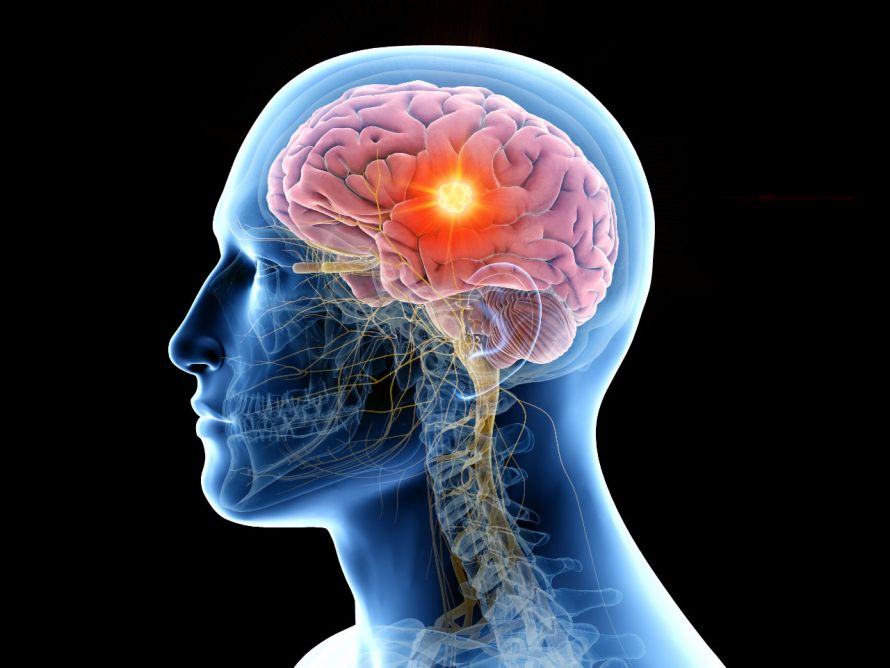Recommended specialists
Brief overview:
- What is a glioblastoma? One of the most common brain tumors, affecting mostly middle-aged people. It grows rapidly into the healthy tissue of the brain instead of displacing it.
- Symptoms: The symptoms and their severity depend on exactly where the tumor is located. Headaches, especially at night or early in the morning, are an important warning sign. In addition, further symptoms include dizziness, coordination problems, impaired vision, seizures, and others.
- Causes and risk factors: The causes are unknown. It is possible that cell renewal leads to errors in the formation of new cells and then forms uncontrolled proliferating tissue. Men are more frequently affected.
- Diagnosis: An MRI is the most important means to identify the tumor. A tissue sample provides further clarity, but surgery is performed without a sample in most cases.
- Treatment: Surgery should be performed as soon as possible. This is often supplemented by radiation and chemotherapy to eliminate residual cancer cells.
- Prognosis: Life expectancies averaging two or more years are possible. The prognosis depends on various factors. Unfortunately, glioblastomas cannot be cured.
Article overview
Definition: What is a glioblastoma?
Glioblastomas belong to the group of so-called diffuse infiltrating brain tumors. This means they grow into healthy brain tissue instead of displacing it. The term "glioma" indicates the outdated assumption that glioblastomas originate from the supporting tissue of the nervous system, the so-called glial cells.
Due to its characteristics, the World Health Organization (WHO) classifies glioblastoma as a grade IV, aggressive tumor. In the majority of cases, a glioblastoma first forms in one of the two cerebral hemispheres (Fig. 1)
Fig. 1: Glioblastoma in an MRI (left) and showing the infiltration zone (double arrows) and trajectory (arrow) not visible on the left MRI. [Source: Prof. Dr. Andreas Raabe, Inselspital Bern]
Symptoms of a glioblastoma
The intensity and severity of the symptoms of a glioblastoma depend on exactly where the brain tumor is located. Depending on the affected brain region, completely different symptoms occur, which often complicates the diagnosis.
Generally, symptoms appear within a few weeks.
The brain cannot avoid the tumor that takes up space within the hard skull. It also cannot adapt to the changed pressure conditions. Therefore, those affected suffer primarily from headaches: especially at night or in the early morning hours.
Patients report that the pain initially improves on its own throughout the day. Unlike other headaches, however, glioblastoma headache recurs at regular intervals. Over-the-counter medications, such as those available in drugstores and pharmacies, become ineffective over time.
In addition, patients with glioblastoma are also more likely to have the following symptoms, which are seen in all brain tumors:
- Dizziness,
- Coordination problems,
- Impaired vision,
- Seizures,
- Personality changes,
- Nausea, and
- Fatigue and general exhaustion.

Anatomically correct depiction of the skull structures with a brain tumor © SciePro | AdobeStock
Causes and risk factors
The exact reasons why glioblastomas form is still unknown. Nevertheless, these tumors are among the most common brain tumors of all. The majority of patients become ill between the ages of 60 and 70. The average age at diagnosis is 64 years, but this does not exclude the possibility that children may also develop glioblastoma.
Interestingly, men are about 1.7 times more likely to be affected by glioblastoma than women. Data from the American Brain Tumor Registry also show that white people in particular develop glioblastoma.
Nowadays, primary and secondary glioblastoma are distinguished according to their origin.
For example, primary glioblastoma arises from astrocytes, which are important supporting cells of the central nervous system. Since these astrocytes are renewed regularly, errors can occur during cell renewal. The cells then start to grow uncontrollably and end up forming the glioblastoma.
Secondary glioblastomas, in turn, develop from pre-existing tumors. They are thus the final stage of a disease that has already lasted for some time.
Ionizing radiation has also been discussed as a possible factor in glioblastoma development. Therefore, especially the internet is full of theories and opinions about the influence of cell phones on glioblastomas and their development. But do brain tumors really result from the use of mobile phones or smartphones?
According to the current state of research, the experts point out that even large-scale epidemiological studies in humans have so far found no evidence that cell phone use leads to an increased risk of developing a brain tumor.
By contrast, complex animal studies indicate an increased risk in male rats and mice for tumors caused by mobile phone radiation. However, they cannot show a dose-response relationship or explain the lack of effect in females. Therefore different authorities classify the hazard potential very differently: From "harmless" to "the possibility of being slightly carcinogenic not excluded".
Examinations and diagnosis
Because glioblastoma symptoms usually occur suddenly, some patients first consult a neurologist. This begins by taking the patient's medical history (anamnesis).
The most important diagnostic tool to reliably detect glioblastoma is and remains magnetic resonance imaging (or an MRI for short). This imaging technique allows physicians to visualize the tumor (Fig. 2).
Fig. 2: Axial MRI T1 sequence with a contrast agent (left) and T2 sequence of an MRI (right). Glioblastoma typically presents as an irregular, annular contrast-enhancing mass. The yellow arrow shows the tumor with its compartments and the double white arrows show the surrounding brain edema. [Source: Prof. Dr. Andreas Raabe, Inselspital Bern]
For example, a bright, ring-shaped structure on MRI images is considered a tumor-suspect area in the brain.
If glioblastoma is suspected, doctors confirm this in part with the help of a tissue sample called a biopsy. In most cases, however, the tumor is operated on immediately without a prior biopsy.
General treatment
Because of the rapid growth of a glioblastoma, surgery should be performed as soon as possible. As the tumor grows in size and time, more cells migrate into the surrounding area. As a result, the tumor continues to expand. At the same time, the risk of surgery increases. Therefore, surgery should ideally be performed within 1-2 weeks after diagnosis.
For a glioblastoma, the current "standard therapy" consists of a combination of
- Microsurgical tumor removal,
- Irradiation, and
- Chemotherapy.
Currently, experts believe that at least 80% of the tumor must be surgically removed for patients to have a survival advantage from the surgery.
Only MRI-complete removal, however, confers a significant survival advantage.
Surgery
For optimal surgical preparation, a special MRI is needed for the most accurate assessment and surgical planning. Depending on the localization, further exams may be required.
Aim of the surgery
Surgical removal (resection) is now an integral part of the treatment concept and its first step. A higher extent of resection influences the progression of the disease favorably; in this respect, MRI-complete tumor resection is the goal of surgery. Furthermore, the removal of the tumor reduces the mass effect and therefore the symptoms at the same time.
Surgical removal of the tumor tissue also allows histological and molecular biological examination of the respective glioblastoma.
In addition, the more tumor that is removed, the greater the survival benefit from surgery. However, the distinction between tumor and brain tissue is often difficult to identify, especially at the margins.
Modern technologies
Therefore, various modern technologies are used in this regard. This includes, for example, microscope-controlled image guidance known as neuronavigation, which uses a GPS-like procedure for millimeter-precise surgeries.
This powerful surgical microscope allows real precision work on the brain. At the operating microscope,
- Fiber tracts drawn before the operation,
- The tumor itself, and
- Other important centers
are shown virtually and projected onto the head’s surface (Fig. 3). This "augmented reality" enables the surgeon to better navigate and plan the approach to the tumor in advance in a customized manner. It is based on the principle of "as small as possible, but as large as necessary".
Fig. 3: Virtual reality by superimposing the drawn-in tumor and fiber tracts in the surgical microscope. A strip of skin is visible in the center, this was shaved, disinfected, and covered with foil before the operation began. The tumor is superimposed on this in red and the important fiber tracts in color. [Source: Prof. Dr. Andreas Raabe, Inselspital Bern]
Quality control after surgery
After the procedure, an MRI image is obtained 24 to 48 hours later for quality control.
Glioblastomas grow very diffusely into the brain tissue. Therefore, even after a "complete" resection on the MRI, a few tumor cells always remain. These must be destroyed by subsequent radiation and chemotherapy. This means that regardless of the MRI image, radiochemotherapy will always be performed.
If tumor remnants are visible on an early control MRI 24-48 hours after surgery, they should be removed in a second operation. The prerequisite is that their location allows it. Often this surgery takes place the very next day.
Experience shows here that despite all the technical aids, removable residual tumor tissue remains in 5-10% of patients. A second surgery is useful in these cases. The experts at Inselspital Bern (Switzerland), for example, were able to show in a study of their own patients that
- This almost always leads to complete removal,
- It is well tolerated, and
- It is associated with only minimal risk for patients.
This procedure only prolonged the hospital stay by about two more days.
Progression and prognosis
Glioblastomas belong to the grade IV tumor group. They are thus assigned to the highest WHO grade for assessing tumors.
The prognosis is significantly improved by the quick initiation of ensuing therapy and especially by the surgical tumor removal. The two pillars of glioblastoma treatment are
- The safe and controlled removal of the tumor and
- The combined use of radiotherapy and chemotherapy.
In terms of life expectancy, an improvement in the number of patients with long-term survival rates can already be observed according to the current state of research. On average, life expectancies of two years or more can be achieved today under optimal and individually adapted treatment conditions.
The individual prognosis depends on a number of factors. The following list shows some of these factors that are thought to have a positive impact on prognosis, such as:
- A younger age,
- Good general condition or performance level,
- No deficits of neurological partial functions before surgery,
- Shorter waiting time before the surgery, i.e., tumor removal as early as possible,
- Minimal or no steroid administration (dexamethasone) before and after surgery,
- No failures of partial neurological functions after surgery, especially no paralysis or partial paralysis resulting as a complication of surgery,
- Complete tumor removal on the T1 MRI using a contrast agent, and
- No complications during/after surgery.
For individual patients, only a rough estimate of the course’s duration is possible, but not an exact prediction. All figures quoted are ultimately based on the "average value" of a large number of patients and do not allow any conclusions to be drawn about individual patients.
A word about methadone
In recent years, there has been increased discussion about methadone in the context of glioblastoma. There are many posts about this on Internet forums, while standard therapies are criticized in the same context.
However, the assumption that methadone helps is not based on systematic, scientifically collected, and publicly available data. To date, there is no evidence of the efficacy of methadone therapy for glioblastomas.
Furthermore, methadone is not without side effects and can significantly reduce quality of life if used improperly. In this context, additional reference should be made to the statement of the German Neuro-oncological Working Group.
Summary
Glioblastomas are one of the most malignant brain tumors. They develop in a relatively short time and mainly affect middle-aged people. The risk factors are largely unknown.
Medical literature is limited to merely stating conjectures that do not go beyond the stage of a theory.
Despite intensive treatment methods, the life expectancy of half of those affected is only 1-2 years after diagnosis. The other half of the patients live longer. However, the disease remains incurable, despite advances in modern medicine and research.




















